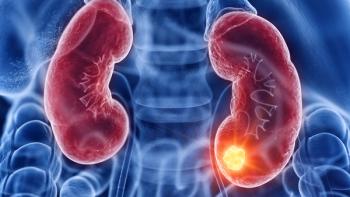
Fixed-Duration Ibrutinib/Venetoclax Improves PFS in Patients With CLL and High-Risk Genomic Features

The complete response or complete response with incomplete bone marrow recovery rate was 61% for patients with chronic lymphocytic leukemia and high-risk disease.
Patients with chronic lymphocytic leukemia (CLL) experienced improvements in progression-free survival (PFS) following frontline treatment with fixed-duration ibrutinib (Imbruvica) plus venetoclax (Venclexta), according to findings of a post hoc analysis of the phase 2 CAPTIVATE study (NCT02910583). The PFS outcomes were determined to be consistent among patients with high-risk genomic features.
The results, published in Clinical Cancer Research, examined a population of patients with genomic risk features associated with poor response to chemoimmunotherapy including 17 deletions (del[17p]), TP53 mutations, or IGHV mutations.
A fixed-dose of ibrutinib (420 mg daily) was administered for 3 cycles followed by 12 cycles of ibrutinib in combination with venetoclax at a target dose of 400 mg once daily after a 5-week ramp-up schedule. Tumor lysis syndrome prophylaxis was administered with the onset of venetoclax dosing.
Of those treated with known risk status (n = 195), 129 patients had high-risk features. the complete response (CR) or complete response with incomplete bone marrow recovery (CRi) was 61% (95% CI, 53%-70%) for patients with high-risk disease compared with 53% (95% CI, 41%-65%) for patients without high-risk disease feature (n = 66). The best overall response for patients with high-risk features and those without high-risk features was 98% and 96%, respectively. Partial response was reported in 36.4% and 40.9% of patients in these groups, respectively.
For those who achieved a CR/CRi, responses lasting at least 12 months were reported in 92% (n = 73 of 79) of patients with high-risk features and in 97% (n = 34 of 35) of those without high-risk features. Investigators also performed a 24-month estimated duration of response and reported that 93% (95% CI, 83%-97%) of patients with high-risk features were expected to maintain a response with 100% of those without high-risk features also expected to maintain a response.
The median time on study for patients with high-risk disease was 38.9 months (range, 0.8-56.4) and 38.8 months (range, 2.6-53.4) for those with low-risk disease.
“CLL is characterized by molecular heterogeneity resulting in variability in disease course, clonal growth rates, and response to treatment,” John N. Allan, MD, and coauthors wrote in the paper. Allan is an assistant professor of medicine in the Division of Hematology and Medical Oncology at Weill Cornell Medicine in New York, New York. “These results support first-line treatment with ibrutinib plus venetoclax as an all-oral, once-daily, chemotherapy-free, fixed-duration regimen that provides clinically meaningful PFS [progression-free survival] and treatment-free remissions in patients with CLL/SLL [small lymphocytic lymphoma], including those with high-risk genomic features.”
Responses were also reported by high-risk genomic characteristics. The best overall response for patients with del(17p)/TP53-mutant disease (n = 29) was 97%, with a CR rate of 48.3%, a CRi rate of 3.4%, and a PR rate of 44.8%. The estimated CR/CRi rate at 24 months was 86% (95% CI, 54%-96%). For those with del(17p)/TP53 wild-type disease (n = 169), the best overall response was 97%, the CR rate was 59.8%, the PR rate was 36.7%, and 0.6% of patients had a nodular PR. The estimated 24-month CR/CRi response in this subgroup was 97% (95% CI, 90%-99%).
Among those with non–IGHV-mutant disease (n = 119), the best overall response was 97%, with a CR rate of 61.3%, and a PR rate of 36.1%. The estimated CR/CRi rate at 24 months was 94% (95% CI, 84%-98%). For those with IGHV-mutant disease (n = 78), the best overall response was 96%, the CR rate was 51.3%, the CRi rate was 2.6%, the nodular PR rate was 1.3%, and the PR rate was 41.0%, with an estimated 24-month CR/CRi rate of 97% (95% CI, 83%-100%).
In a subgroup of patients with no variant alterations in either TP53, del(17p), or IGHV (n = 100), the CR/CRi rate was 64% (95% CI, 55%-73%) with 95% (95% CI, 84%-98%) of patients expected to maintain a response at 24 months.
Undetectable minimal residual disease (uMRD) was also reported. In patients with high-risk features, the uMRD rate in the peripheral blood was 88% (95% CI, 83%-94%) and was 72% (95% CI, 83%-94%) in the bone marrow. For those without high-risk features, these rates were 70% (95% CI, 59%-81%) and 61% (95% CI, 49%-72%), respectively.
Among those who achieved a CR/CRi in the high-risk features group (n = 79), the best uMRD response was 96% in the peripheral blood and 78% in the bone marrow. For patients without high-risk features, the best uMRD response among those with a CR/CRi (n = 35) was 83% in the peripheral blood and 77% in the bone marrow.
“[Although] uMRD rates were relatively consistent among patients with and without high-risk features, analysis of uMRD rates by individual high-risk features showed lower bone marrow uMRD rates in patients with del(17p)/TP53 mutation,” the authors wrote.
Specifically, the best uMRD rates in those with del(17p)/TP53 mutation were 83% (95% CI, 69%-97%) in the peripheral blood and 45% (95% CI, 27%-63%) in the bone marrow. For those without these variants, the rate of uMRD in the peripheral blood and bone marrow were 82% (95% CI, 76%-88%) and 72% (95% CI, 65%-79%), respectively.
In those with non–IGHV-mutant disease, the rate of uMRD was 88% (95% CI, 82%-94%) and 73% (95% CI, 65%-81%) in the peripheral blood and bone marrow, respectively. For those with IGHV-mutant disease the best uMRD rates were 72% (95% CI, 62%-82%) and 60% (95% CI, 49%-71%). In the subset of patients with none of the high-risk mutations, the best uMRD rates in the peripheral blood and bone marrow were 90% (95% CI, 84%-96%) and 80% (95% CI, 72%-88%).
PFS and overall survival (OS) demonstrated only “slight” differences when broken into subgroups and were similar in the overall population of patients with or without high-risk features, according to investigators. “Results from this pooled analysis of patients treated with fixed-duration ibrutinib plus venetoclax in the CAPTIVATE study confirm that deep, durable responses and sustained PFS seen with fixed-duration ibrutinib plus venetoclax are maintained in patients with 1 or more high-risk genomic features [del(17p), TP53 mutation, or unmutated IGHV], with PFS and OS rates that are similar to patients without high-risk features,” the authors wrote in the discussion.
The 36-month PFS rates among those with high-risk genomic features was 88% (95% CI, 81%-93%) and was 92% (95% CI, 82%-97%) for those without high-risk features. The 36-month OS rate was 98% (95% CI, 93%-99%) and 100% (95% CI, 100%-100%) among those with and without high-risk features.
By genomic feature subgroup analysis, the 36-month PFS rates were as follows: del(17p)/TP53 mutations (81% [95% CI, 61%-92%]), those without del(17p)/TP53 mutations (91% [95% CI, 85%-94%]), those without IGHV mutations (88% [95% CI, 80%-93%]), and those with IGHV mutations (92% [95% CI, 83%-96%]). The 36-month OS rates were 96% (95% CI, 77%-100%), 99% (95% CI, 95%-100%), 98% (95% CI, 92%-99%), and 100% (95% CI, 100%-100%), respectively.
In a safety analysis, the most common treatment-emergent adverse effects (TEAEs) in the high-risk and non–high-risk groups were diarrhea (62% and 59%), neutropenia (46% and 55%), nausea (42% and 44%), arthralgia (33% and 32%), headache (26% and 29%), upper respiratory tract infection (25% and 30%), fatigue (23% and 33%), muscle spasms (22% and 32%), vomiting (18% and 23%), and increased tendency to bruise (18% and 26%).
Grade 3/4 TEAEs reported in at least 5% of patients included neutropenia (36% in both cohorts) and hypertension (9% in the high-risk group, 3% in the non–high-risk group). Of clinical interest, atrial fibrillation was reported in 6% of high-risk patients and 3% of patients without high-risk features, with major hemorrhage occurring in 2% and 1% of patients, respectively. Serious AEs were related to therapy were reported in 12% and 15% of patients in the high-risk and non–high-risk group, respectively.
Of note, 94% of patients with and without high-risk features completed treatment with the fixed-dose regimen. At the time of the post hoc analysis, 20% of patients with high-risk features had progressive disease compared with 8% of those without high-risk features. Of note, for the 26 patients who had disease progression and had testing done, no resistance mutations (BTK, PLCg2, or BCL2) were detected.
Reference
Allan JN, Flinn IW, Siddiqi T, et al. Outcomes in patients with high-risk features after fixed-duration ibrutinib plus venetoclax: phase II CAPTIVATE study in first-line chronic lymphocytic leukemia. Clin Cancer Res. Published online June 7, 2023. doi:10.1158/1078-0432.CCR-22-2779
Newsletter
Knowledge is power. Don’t miss the most recent breakthroughs in cancer care.
























































































